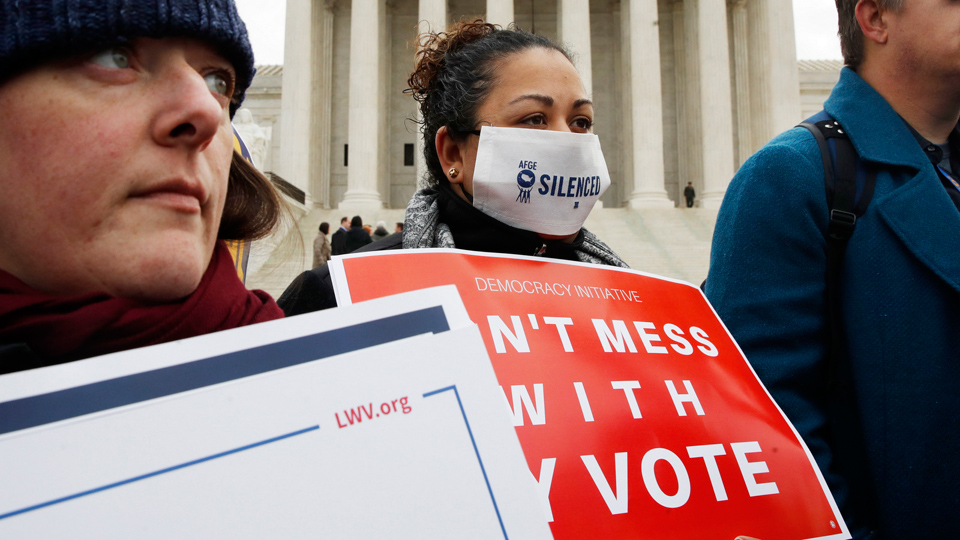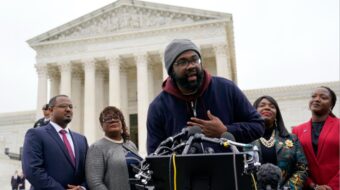
The developing consensus is that the midterm elections this November will be a “blue wave.” Never-Trump Republicans, conservatives, and progressive and centrist Democrats see a probable outcome of Democratic control of the House and maybe even the Senate. Both, or a change in control of the House alone, would be a tremendous political victory in the quest to halt President Trump as well as the Right.
There is plenty of evidence to support the argument. For example, since Trump’s 2017 inauguration, in nearly 100 special elections on the state and national levels in more than half of our states, Democrats have significantly outperformed their Republican counterparts.
However, Trump’s victory and this year’s primary upsets expose the risky business of predicting elections. More importantly, readers should take a step back and realize that in most cases, state governments hold the key to control in Washington, D.C. To put it bluntly, control of state governments leads to control of the House.
Census and Redistricting
Every 10 years, our country conducts a census, officially trying to count every person in all 50 states. Notwithstanding all of the undercounting and lowering response rates, as well as Trump’s controversial insertion of a citizenship question, each new census results in a redistribution of the 435 House seats. The next one will be in 2020.
States with significantly increased populations will gain seats, and those with significantly decreased populations will lose seats. In either case, congressional district boundaries must be redrawn. But in potentially nearly every state, the congressional districts might be reconfigured because intra-state populations may have shifted, and each district must be nearly equally populated.
Who does the redrawing and how it is done varies from state to state. All of this is laid bare in the extremely helpful website All About Redistricting, by Justin Levitt, constitutional law scholar and professor at Loyola Law School.
Seven states have only one congressional district: Alaska, Delaware, Montana, North Dakota, South Dakota, Vermont and Wyoming. So unless any of them witness an unlikely massive population increase, they don’t figure in this discussion.
| States with Only One Congressional District | |
| 1 | Alaska |
| 2 | Delaware |
| 3 | Montana |
| 4 | North Dakota |
| 5 | South Dakota |
| 6 | Vermont |
| 7 | Wyoming |
In the most democratic cases, four states have independent commissions redraw their respective congressional districts. As Levitt explains, in Arizona, California, Idaho and Washington, neither legislators nor public officials are allowed to be commissioners, and the commissioners are banned from running for office in the districts they design. Legislative staff (in Arizona and California) and lobbyists (in California, Idaho and Washington) cannot serve on the commissions.
| States with Independent Commissions | |
| 1 | Arizona |
| 2 | California |
| 3 | Idaho |
| 4 | Washington |
Hawaii and New Jersey use “politician commissions.” In Hawaii, the political commissioners are chosen by the Republican and Democratic leaders in the State Senate and State House (with the remaining commissioner chosen by the other commissioners). In New Jersey, a similar process is followed, except the heads of the two major parties also are involved. Thus, the state house and senate do not redraw the lines though the highest ranking legislative leaders pick the commissioners. Not “independent,” but not done by the state’s lawmakers.
| States with Politician Commissions | |
| 1 | Hawaii |
| 2 | New Jersey |
So what about the remaining 37 states? In all of these cases, the state legislatures have direct and overwhelming influence over the new boundary lines.
In nearly all of them, the proposed districts require a majority vote in the lower and upper houses and are subject to veto by each respective governor. There is some variation. For example, Connecticut and Maine require supermajorities in each house, and Connecticut, Florida, Maryland, Mississippi and North Carolina set the district lines by joint resolution, which negates the possibility of gubernatorial veto.
In eight of these 37 states, there are some limitations. In Iowa, Maine, New York, Ohio and Rhode Island, “advisory commissions” submit recommendations for the new district borders. While the commissions’ advice can greatly influence these states’ legislatures, lawmakers are not bound to accept the recommendations. In Virginia, via a 2011 executive order from the governor, the legislature is to consider an advisory commission, but the results of this are not yet clear. And in Connecticut and Indiana, if lawmakers fail to pass a plan (or they pass one that is vetoed), a “backup commission” intervenes.
| States with Advisory Commissions | States with Backup Commissions | |||
| 1 | Iowa | 1 | Connecticut | |
| 2 | Maine | 2 | Indiana | |
| 3 | New York | |||
| 4 | Ohio | |||
| 5 | Rhode Island | |||
| 6 | Virginia | |||
This leaves 29 states—every state not mentioned above—in which the state legislatures, subject to gubernatorial veto in all but four cases, are otherwise completely unfettered in the redrawing of congressional boundaries after each new census.
| States with Nearly Unfettered State Legislative Control | ||||
| 1 | Alabama | 16 | Nebraska | |
| 2 | Arkansas | 17 | Nevada | |
| 3 | Colorado | 18 | New Hampshire | |
| 4 | Florida (no veto possibility) | 19 | New Mexico | |
| 5 | Georgia | 20 | North Carolina (no veto possibility) | |
| 6 | Illinois | 21 | Oklahoma | |
| 7 | Kansas | 22 | Oregon | |
| 8 | Kentucky | 23 | Pennsylvania | |
| 9 | Louisiana | 24 | South Carolina | |
| 10 | Maryland (no veto possibility) | 25 | Tennessee | |
| 11 | Massachusetts | 26 | Texas | |
| 12 | Michigan | 27 | Utah | |
| 13 | Minnesota | 28 | West Virginia | |
| 14 | Mississippi (no veto possibility) | 29 | Wisconsin | |
| 15 | Missouri | |||
Different Methods, Different Outcomes
The different methods of redrawing congressional boundaries make a massive difference in whether those districts are gerrymandered. A report by Daniel McGlone and Esther Needham of Azavea, a so-called B corporation, attempts to rank the most gerrymandered states by an “efficiency gap” and how many seats in the House are captured by the party doing the gerrymandering (“seat advantage”). Combining their research findings with Levitt’s categories, we can confidently indict the Republican Party with “crimes against democracy.” (The Democratic Party would only be fined.)
While gerrymandering is impossible in the seven states with only one congressional district, McGlone and Needham found no gerrymandered districts in both the four states with independent commissions and also the two states with politician commissions. In the six states with advisory commissions, Republican-gerrymandered districts in Iowa, Ohio and Virginia resulted in a gain of three seats to the GOP, while the Democrats’ manipulation of boundaries in New York resulted in their gain of two seats.
Concerning the backup commission states, Democratic-controlled Connecticut resulted in a seat advantage of one, while Republican-controlled Indiana had a similar advantage for the GOP.
In the remaining 29 states—the ones with unfettered state legislative control—ten states had no gerrymandered districts. Seven states (Illinois, Maryland, Massachusetts, Minnesota, Nevada, New Hampshire and Oregon) saw gerrymandered districts giving the Democrats an advantage of seven seats. In the remaining 12 states—Alabama, Florida, Georgia, Kansas, Michigan, Nebraska, North Carolina, Pennsylvania, South Carolina, Texas, Utah and Wisconsin—Republicans manipulated the districts to win 18 extra House seats.
McGlone and Needham show the sum total damage of these maneuvers. In the 2016 elections, the Democrats won 193 seats and the Republicans won 242. If there was no “seat advantage,” the numbers instead would have been 206 to 229. I used their data, and if the presidential vote was proportionally repeated for congressional seats, the numbers would have been 211 to 224.
The Republicans would still have been the majority party by either recount. However the number of seats needed by the Democrats to win back control of the House this November would have been significantly lower.
Party Control and Redistricting
Currently, only Alaska’s governor is an independent while 16 governors belong to the Democratic Party, and the remaining 33 are Republicans. Because most congressional redistricting plans face possible gubernatorial veto, this greatly matters. More often than not, however, Republican governors will be smiling when presented with the plan, because a full 26 states have Republican governors and Republican majorities of the state lawmakers.
Nebraska has a Republican governor and a unicameral, “nonpartisan” legislature that is dominated by a GOP majority. In the other 25 states, Republicans hold majorities in both houses.
Of these 26 states, three (North Dakota, South Dakota and Wyoming) have only one congressional district, and two (Arizona and Idaho) use the independent commission method. Therefore, in the remaining 21 states, the state legislatures are the primary agency to redraw congressional districts. Two (Iowa and Ohio) use advisory commissions, and one (Indiana) uses a backup commission.
Hence, if the census took place today, Republican-dominated legislatures in 18 states would redraw their states’ congressional districts without any interference and with Republican governors most likely not vetoing the plans.
| State Governments Dominated by Republicans | ||
| Redistricting Method | ||
| 1 | Alabama | Legislative Control |
| 2 | Arkansas | Legislative Control |
| 3 | Florida | Legislative Control |
| 4 | Georgia | Legislative Control |
| 5 | Kansas | Legislative Control |
| 6 | Kentucky | Legislative Control |
| 7 | Michigan | Legislative Control |
| 8 | Mississippi | Legislative Control |
| 9 | Missouri | Legislative Control |
| 10 | Nebraska | Legislative Control |
| 11 | New Hampshire | Legislative Control |
| 12 | Oklahoma | Legislative Control |
| 13 | South Carolina | Legislative Control |
| 14 | Tennessee | Legislative Control |
| 15 | Texas | Legislative Control |
| 16 | Utah | Legislative Control |
| 17 | West Virginia | Legislative Control |
| 18 | Wisconsin | Legislative Control |
| 19 | Indiana | Backup Commission |
| 20 | Iowa | Advisory Commission |
| 21 | Ohio | Advisory Commission |
| 22 | Arizona | Independent Commission |
| 23 | Idaho | Independent Commission |
| 24 | North Dakota | Only one CD |
| 25 | South Dakota | Only one CD |
| 26 | Wyoming | Only one CD |
Yes, there has been some gerrymandering under Democratic Party-dominated states, but as McGlone and Needham show, it has not been nearly as efficient as the job done by the Republicans.
We Don’t Need More Democrats?
There is currently a slogan floating about in progressive circles: “We Don’t Need More Democrats.” Or sometimes it becomes a bit more refined into, “We Don’t Just Need More Democrats, We Need Better Ones.” I understand the sentiment and the notion that progressive Democrats might be better suited than their centrist counterparts to mobilize voters and win, especially in friendly dark blue districts, but I also believe this thinking quickly becomes sectarian.
If we are discussing the first slogan, I think the people who say it are mathematically challenged. With both slogans, the logical conclusion is that since “not great” Democrats are of little value, Republican victories aren’t such a bad thing. The findings above regarding gerrymandered districts completely refute that notion.
Party Control and Voting Rights
Furthermore, that logical conclusion completely ignores the policy differences between the two parties. Take the issue of voting rights. As documented by the Brennan Center for Justice, after the 2010 elections—what President Obama called a “a shellacking,” with many Tea Party candidates winning—state lawmakers all over the country introduced measures making it harder to vote, ranging from “strict photo ID requirements to early voting cutbacks to registration restrictions.”
New restrictions remain in place in 23 states. In 2016, 14 states had new voting restrictions “for the first time in a presidential election.” Excluding Rhode Island and Virginia, all of the states—Alabama, Arizona, Indiana, Kansas, Mississippi, Nebraska, New Hampshire, Ohio, South Carolina, Tennessee, Texas, and Wisconsin—had Republican majorities in the state legislatures and Republican governors.
Last year, seven states enacted further restrictions. Excluding the ballot initiative passed by the voters of Missouri, all of those laws were passed by Republican-majority state legislatures and signed by GOP governors. These states are Arkansas, Georgia, Iowa, Indiana, New Hampshire and North Dakota.
Conclusions
Gerrymandered districts perpetuate Republican control. So too does restricting the franchise. With increasing GOP domination, the democratic base of the Democratic Party—labor unions, African Americans, Latinos, immigrant rights organizations, LGBT communities, environmental groups, students, etc.—is increasingly shut out and legislated against.
More Democrats and third party or independent lawmakers in coalition with the Democratic Party is the only way to stop this at this moment in history. And a sober look at who’s who in the Democratic Party today leads to the next obvious conclusion: there must be a coalition between its progressive and centrist (“establishment” or “corporate,” if you prefer) wings.
Honest assessments must conclude that in extremely red districts, centrists and not progressives might have better odds in defeating ultra-Right candidates. Such is the state of America in 2018. A blue wave engulfing the House (and the Senate) can inject much-needed momentum into this fight. So can this November’s state-level races across all 50 states.
It is past time for the Left, all progressives and all liberals, whether left-liberals or centrists, to focus on the states. Control of the federal and state legislative branches is at stake.

MOST POPULAR TODAY

High Court essentially bans demonstrations, freedom of assembly in Deep South

Zionist organizations leading campaign to stop ceasefire resolutions in D.C. area

UN warns that Israel is still blocking humanitarian aid to Gaza


U.S. imperialism’s ‘ironclad’ support for Israel increases fascist danger at home






Comments